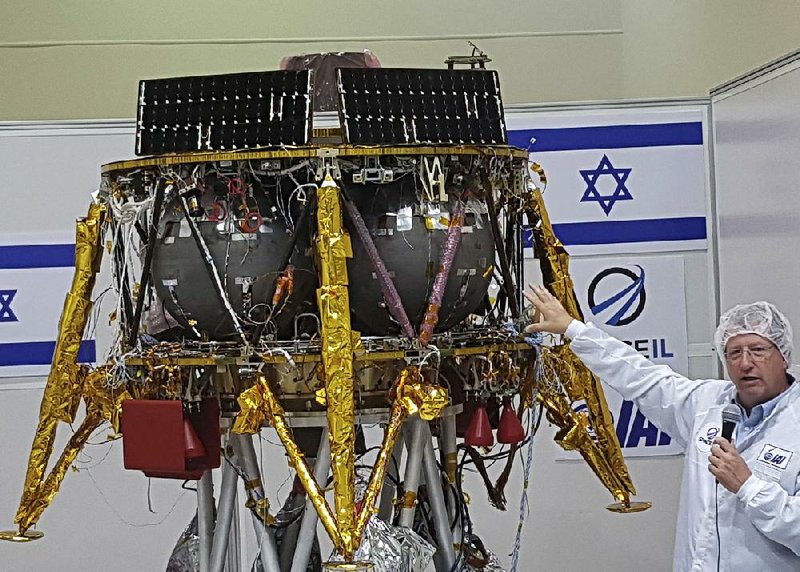YEHUD, Israel -- Thursday morning, the first privately funded spacecraft to journey to the moon fired its engines for 6 minutes, slowing down enough to be captured by the moon's gravity. The maneuver appeared to have been executed without problems.
"This was a milestone and it actually gives us a real shot at the moon," said Yonatan Winetraub, co-founder of SpaceIL, the Israeli nonprofit that built the spacecraft.
The lander, dubbed Beresheet, Hebrew for "Genesis," or "In the Beginning," is among the smallest spacecraft in history to have entered the moon's orbit.
From the control center in Yehud, near Tel Aviv, a crowd of engineers tracked the spacecraft's speed. In order to catapult away from Earth and "catch" the moon's gravitational pull, Beresheet needed to slow down from 5,300 mph to 4,700 mph.
Spectators observed from behind glass, holding their collective breath as screens showed Beresheet's engines kicking into gear.
After 5 minutes, Beresheet hit the perfect velocity, and the engineers burst into applause, congratulating one another with hugs and handshakes.
A failure to slow down would have brought the mission to an abrupt end.
"The price of a mistake here would have been infinite," said Opher Doron, space division general manager at aerospace and aviation manufacturer Israel Aerospace Industries, which worked with SpaceIL on the project. "We would have been spinning in space toward some sun orbit that no one wants to go into."
Now in an elliptical orbit, the spacecraft will fly within 310 miles of the moon's surface and swing out as far as 6,200 miles away. Three more engine firings over the next week will push Beresheet into a circular orbit 124 miles above the surface, keeping it on track for touchdown next Thursday.
"There is a significant chance we have a crash-landing," said Doron. "It's very dangerous, and it's difficult to predict we'll succeed."
But, he added, after completing Thursday's challenge, the team was optimistic.
Unlike giant, powerful NASA rockets that hurtle directly toward the moon, the humble four-legged landing craft, barely the size of a washing machine, was sent on a risky and roundabout route.
The $100 million mission couldn't afford its own rocket, so Beresheet hitched a ride on the SpaceX Falcon rocket, launched from Florida in February.
In total, the spacecraft will traverse about 4 million miles, among the longest distances ever traveled to the moon, which is about 240,000 miles from Earth.
SpaceIL got its start in the Google Lunar X Prize Competition, which promised $20 million for the first privately funded robotic spacecraft to make it to the moon.
The competition ended last year without a winner. But inspired by SpaceIL's perseverance, the XPrize Foundation announced last week that it would offer the team $1 million if Beresheet sticks its landing.
If all goes according to plan, Beresheet will land on a plain of solidified lava, known as the Sea of Serenity. It will spend a couple of days on the moon's surface, measuring the magnetic field at the landing site, and send back data and pictures.
A successful mission would make Israel the fourth country to pull off a moon landing, after the U.S., Russia and China.
SpaceIL hopes its feat will inspire the next generation of Israelis to study science and engineering.
Winetraub described how during the recent Jewish holiday of Purim, he saw many children dressed up as Beresheet and as astronauts. "It's amazing to see the amount of excitement we've already generated," he said. "That is what's going to propel our country forward."
Beresheet's success comes during renewed interest in exploring the moon. China earlier this year set down its Chang'e-4 robotic spacecraft on the far side of the moon, the first nation to do so. NASA hopes to send scientific payloads on commercial landers to the moon as soon as this year.
President Donald Trump's administration wants to send astronauts back to the moon, and it announced that it would like to accelerate the program, with new astronaut footprints on the lunar surface as soon as 2024. NASA has not yet laid out how much it would cost to get people there that quickly, and some members of Congress have questioned why there is a rush.
India also intends to place its robotic Chandrayaan-2 lander on the moon this year. At one point it seemed as if India and Israel might be in a moon-landing race, but the launch of the Indian spacecraft has faced a series of delays, with news reports recently suggesting a May launch date.
Information for this article was contributed by Isabel Debre of The Associated Press and by Kenneth Chang of The New York Times.
Business on 04/05/2019
